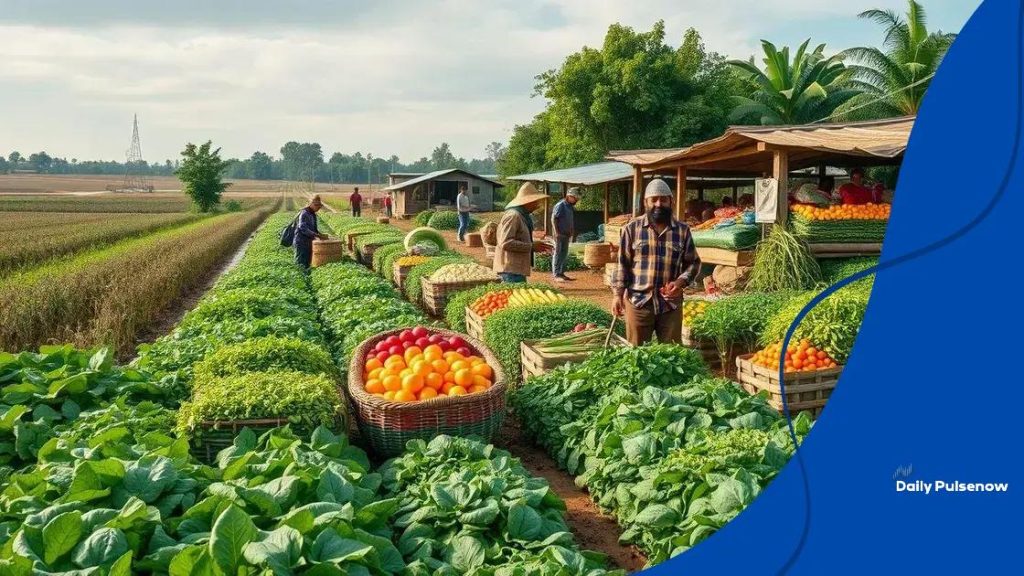Agricultural exports increase: explore the benefits now

Anúncios
Agricultural exports increase can be significantly boosted by product diversification, technology implementation, and strong buyer relationships, while overcoming challenges like regulations and market competition.
Agricultural exports increase plays a crucial role in strengthening economies and fostering development. Have you ever wondered how these dynamics affect local communities and global markets? Let’s dive deeper into this vital topic.
Anúncios
Key factors driving agricultural exports
Several key factors driving agricultural exports highlight the dynamics of global trade. These elements not only affect the volume of exports but also influence the markets that depend on agricultural goods. Understanding these factors can help stakeholders make informed decisions.
Supply and Demand
One of the primary factors affecting agricultural exports is supply and demand. When there is a high demand for certain agricultural products, and the supply can meet or exceed that demand, exports are likely to increase. Factors such as population growth and dietary changes can amplify this demand.
Technological Advancements
In recent years, technological advancements have transformed agricultural practices. These innovations enhance productivity and efficiency, leading to higher quality products that can compete in international markets. Examples include precision farming technologies and improved seed varieties.
Anúncios
- Increased crop yields
- Enhanced disease resistance
- Better resource management
- Reduced production costs
Another critical factor is trade policies. Government regulations and trade agreements can significantly impact the ability of countries to export their agricultural products. Favorable trade agreements can open new markets and facilitate smoother transactions.
Market access is essential for exporters. Having reliable transportation and logistics networks is crucial to ensure that agricultural products reach the consumer efficiently. This infrastructure supports both local and international trade.
Climate Change Effects
Lastly, climate change plays an important role in agricultural exports. Changes in weather patterns can impact crop production, making it essential for farmers to adapt to new conditions. Sustainable practices not only help mitigate climate impacts but also enhance the reputation of exporting nations.
Recognizing and adapting to these key factors driving agricultural exports can lead to better planning and investment. Stakeholders who prioritize these elements can strengthen their market position and ensure sustainable growth.
Impact of technological advancements on exports
The impact of technological advancements on exports is significant, revolutionizing the way agricultural products are produced and marketed. Innovative technologies boost productivity and quality, providing farmers with tools to thrive in competitive markets.
Precision Agriculture
One major advancement is precision agriculture. This approach uses data and technology to manage fields more effectively. Farmers can monitor soil health, crop growth, and weather patterns closely, allowing for targeted interventions.
- Improved crop yields
- Efficient water usage
- Reduced input costs
- Enhanced decision-making based on data
Another development is the use of drones and satellite imagery. These tools offer real-time analysis of crop conditions and land usage. Drones can scout fields quickly, enabling farmers to identify issues like pest infestations or nutrient deficiencies early.
Moreover, biotechnology has introduced genetically modified organisms (GMOs) that are resistant to pests and diseases. These innovations can lead to a more stable supply of agricultural exports, even in unfavorable climate conditions.
Supply Chain Innovations
Technological advancements also streamline supply chains. Automated processes in packaging and shipping ensure that products are delivered fresh and on time. With the aid of software solutions, farmers and exporters can track shipments easily and manage inventories efficiently.
Furthermore, e-commerce platforms are changing how agricultural products reach consumers. Farmers can now connect directly with buyers, reducing the reliance on traditional distribution channels. This shift opens new markets and increases profit margins.
As technology continues to evolve, its impact on agricultural exports will likely grow even more profound. Adapting to these changes is essential for farmers and exporters aiming to remain competitive on the global stage.
Trends in global agricultural markets

Understanding the trends in global agricultural markets is vital for farmers and exporters alike. These trends shape the demand for various products and influence prices, directly affecting the agricultural economy.
Shifting Consumer Preferences
One of the most significant trends is the change in consumer preferences. Shoppers today are increasingly interested in organic and sustainably sourced products. As health consciousness rises, there is a greater demand for high-quality produce. This shift encourages farmers to adopt more sustainable practices.
- Higher demand for organic fruits and vegetables
- Interest in local sourcing
- Preference for non-GMO products
- Focus on environmentally friendly practices
Another notable trend is the expansion of international trade. Emerging markets are increasingly participating in global trade, leading to new opportunities for exporters. Countries like China and India are becoming key players, driving demand for various agricultural commodities.
Technological Integration
In addition to changing consumer preferences, technological integration continues to shape agricultural markets. The rise of e-commerce platforms allows farmers to reach more consumers directly. These online marketplaces break down traditional barriers, enabling easy access to global markets.
Moreover, advancements in logistics and transportation improve the speed and efficiency of shipping agricultural products. This means fresher produce can reach markets faster, enhancing overall trade effectiveness. Investing in technology is essential for farmers who want to stay competitive in this evolving landscape.
Global climate change also affects agricultural market trends. Weather patterns are shifting, leading to variability in crop yields and supply. Farmers must adapt to these changes to mitigate risks. This adaptation often involves diversifying crops and investing in drought-resistant varieties.
By keeping an eye on these trends in global agricultural markets, stakeholders can better navigate the complexities of international trade and make informed decisions that support sustainable growth.
Challenges faced by exporters today
The challenges faced by exporters today are numerous and can significantly impact trade efficiency. Navigating these obstacles requires awareness and adaptability from stakeholders in the agricultural sector.
Regulatory Hurdles
One of the primary challenges is the complex regulatory environment. Exporters must comply with various international standards and regulations that can vary widely from country to country. This includes food safety regulations, labeling requirements, and tariffs, which can delay shipments and increase costs.
- Compliance with food safety standards
- Understanding different country regulations
- Managing tariffs and trade barriers
- Dealing with export documentation
Additionally, exporters face logistical difficulties. Efficient transportation and distribution systems are essential for timely delivery of agricultural goods. Issues like supply chain disruptions or transportation costs can severely affect an exporter’s ability to compete in the market.
Market Competition
Market competition poses another significant challenge. With globalization, exporters must compete not only domestically but also with international producers. This increased competition can drive prices down and reduce profit margins, making it essential for exporters to differentiate themselves.
Moreover, fluctuations in demand can create instability. For instance, sudden changes in consumer preferences can leave exporters with unsold products. This volatility requires that exporters remain agile and ready to adapt their strategies.
Economic factors such as currency fluctuations can also affect profitability. A strong local currency can make exports more expensive on the global market, potentially leading to decreased sales. Exporters must constantly monitor these economic indicators to make informed decisions.
As a result of these factors, maintaining strong relationships with buyers becomes crucial. Clear communication and reliable partnerships help exporters navigate challenges more effectively. By understanding the challenges faced by exporters today, stakeholders can better prepare for the complexities of agricultural trade.
Strategies for boosting agricultural exports
Implementing effective strategies for boosting agricultural exports can significantly enhance market presence and profitability. Understanding how to navigate the complexities of exporting is crucial for farmers and businesses alike.
Diversifying Products
One of the primary strategies is diversifying the product range. By offering a variety of crops and goods, exporters can attract different markets and reduce reliance on a single product. This flexibility helps to manage risks associated with market fluctuations.
- Introducing specialty crops
- Exploring organic options
- Creating value-added products
- Adapting to consumer trends
Another important strategy is strengthening relationships with international buyers. Establishing trust and clear communication builds long-term partnerships. Engaging in regular dialogue with clients can lead to better understanding of their needs and preferences.
Investing in Quality and Compliance
Investing in quality control is essential for maintaining a competitive edge. Products must meet the standards set by importing countries. Regular inspections and quality assurance processes can ensure that products are safe and desirable.
Moreover, compliance with international regulations and certifications can open doors to new markets. Certifications like Fair Trade or organic labels can enhance the marketability of products, appealing to conscious consumers.
Utilizing technology is another effective way to boost exports. From precision agriculture to e-commerce platforms, technology can streamline processes and improve product visibility. Leveraging digital tools allows farmers to reach broader audiences and track their sales effectively.
Finally, government programs and incentives can provide necessary support for exporters. By taking advantage of grants or assistance programs, businesses can enhance their exporting capacities. This support can help in marketing efforts and in expanding operational capabilities.
By implementing these strategies for boosting agricultural exports, stakeholders can effectively respond to market demands and increase their competitive advantage.<\/p>
FAQ – Frequently Asked Questions about Agricultural Exports
What are the main challenges faced by agricultural exporters?
Agricultural exporters face challenges such as complex regulations, market competition, logistical difficulties, and fluctuating demand.
How can technology improve agricultural exports?
Technology, such as precision agriculture and e-commerce platforms, can enhance productivity, improve visibility, and streamline distribution processes.
Why is it important to diversify agricultural products?
Diversifying products helps exporters reduce reliance on a single crop, attract different markets, and manage risks associated with price fluctuations.
How can exporters strengthen relationships with buyers?
Exporters can strengthen relationships by maintaining clear communication, understanding buyer needs, and providing consistent quality in their products.